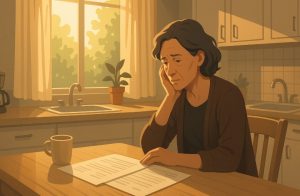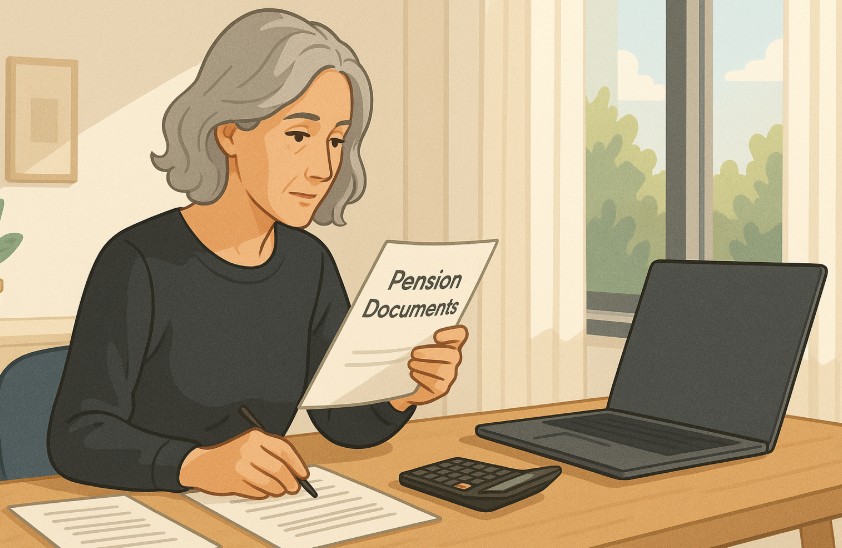Losing a partner is a deeply emotional and life-changing event. Beyond the personal grief, many surviving spouses or common-law partners are faced with the practical concern of financial stability. If you’re in Canada and wondering what financial help might be available after the death of a spouse, the Canada Pension Plan (CPP) Survivor’s Pension may offer the support you need.
This monthly benefit is designed to help surviving spouses or partners continue with their lives after a loved one’s death. But many questions arise: how much is it? Do you qualify? How is it calculated? This guide answers all those questions in detail so you’re fully informed.
What Is the CPP Survivor’s Pension?

The CPP Survivor’s Pension is a monthly payment available to the surviving legal spouse or common-law partner of a deceased contributor. To qualify, the deceased must have made sufficient contributions to the Canada Pension Plan during their working life. The benefit is not paid automatically, you must apply to receive it.
You may be eligible to receive this pension if:
- You were legally married to the deceased contributor
- You were in a common-law relationship with the deceased for at least one continuous year
- You were separated, but the deceased had no other common-law partner
- You had reunited with your separated legal spouse and lived together for at least 12 months before their death
There are specific rules to consider if you were widowed more than once. In such cases, only the larger of the two survivor pensions will be paid. Unlike old rules that ended benefits upon remarriage, your survivor’s pension will continue even if you remarry.
You will not be eligible if:
- You are a separated legal spouse, and a CPP credit split was processed and approved in January 2025 or later for the same contributor
It’s important to know that if you previously lost benefits due to remarriage before 1987, you may now qualify again. Contact CPP directly to explore eligibility in such cases. Overall, eligibility hinges on your relationship with the deceased and their CPP contribution history.
How Much Can You Receive from a Widow’s Pension in Canada?

Determining how much you can receive from the CPP Survivor’s Pension depends on several key factors, including your age and your late spouse or partner’s CPP contributions. The benefit is not a one-size-fits-all amount. The Government of Canada uses a calculation formula based on contribution history and your personal circumstances.
Younger survivors generally receive a higher average benefit due to a flat-rate component, while older survivors receive a percentage of the deceased’s retirement pension.
What is the Average Monthly Amount in 2025?
As of April 2025, the average monthly survivor’s pension for new beneficiaries is:
- $534.64 for individuals under 65
- $335.68 for those 65 and older
These values are not fixed. They represent average amounts based on typical contribution levels. Your benefit could be higher or lower depending on the deceased’s earnings and years of contribution to CPP.
What is the Maximum Survivor’s Pension Amount?
The maximum amounts that can be paid in 2025 are:
- $770.88 per month for survivors under 65
- $859.80 per month for those 65 and older
The exact figure you receive depends on your unique case, and it could be lower if you’re also receiving other CPP benefits.
Here’s a simplified breakdown:
| Age Group | Average Monthly Payment (2025) | Maximum Monthly Payment (2025) |
| Under 65 | $534.64 | $770.88 |
| 65 and older | $335.68 | $859.80 |
How Does Your Age Affect Your Payment?
Your age directly impacts how your benefit is calculated:
- If you are under 65, you’ll receive a flat-rate portion plus 37.5% of the deceased’s retirement pension.
- If you are 65 or older, you typically receive 60% of the retirement pension.
This difference means younger survivors may receive slightly higher payments due to the addition of the flat-rate amount. The exact impact of age on your benefit becomes even more important when combining multiple CPP benefits, which we’ll cover later in this blog.
How Is the CPP Survivor Pension Calculated?

The amount of the CPP Survivor’s Pension is not automatically determined by a standard number, it is carefully calculated using several variables. The key factors include your age at the time of the contributor’s death, the contributor’s CPP contribution record, and whether you’re already receiving another CPP benefit.
What’s the 60% Rule?
If you’re 65 or older and not receiving any other CPP benefits, you will typically receive 60% of your late spouse or partner’s retirement pension. This rule forms the basis for calculating the benefit for older recipients.
What if You’re Under 65?
If you’re under 65, the calculation is a bit more complex. You receive:
- A flat-rate portion (a fixed monthly amount)
- Plus 37.5% of the contributor’s calculated retirement pension
Keep in mind, you won’t receive both a full survivor’s pension and full retirement or disability benefits if you qualify for multiple programs. There are limits on combined amounts, which are based on the highest applicable benefit and age-based adjustments.
How Do the Deceased’s CPP Contributions Affect Your Payment?
The deceased’s CPP contributions are fundamental in calculating your survivor’s benefit. The longer and more consistently they contributed to the CPP, the higher your payment will likely be. The government calculates what their retirement pension would have been at age 65 and then applies your age-based survivor percentage.
Here’s a basic table to illustrate:
| Situation | Calculation Method |
| Survivor under 65 | Flat-rate + 37.5% of deceased’s pension |
| Survivor 65 or older | 60% of deceased’s pension |
| Deceased’s high contribution | Higher survivor benefit |
| Deceased’s low contribution | Lower survivor benefit |
Payments also consider whether the survivor is receiving any other CPP benefits, which can reduce the amount paid through caps or maximums.
What Other Financial Support Can You Get?
Besides the CPP Survivor’s Pension, there are additional financial supports available to surviving spouses and families. The CPP Death Benefit is a one-time payment of up to $2,500. This is designed to assist with funeral costs or other final expenses. The amount may be less depending on the contributor’s contributions, but the maximum is capped.
Survivors aged 60 to 64 with low income may be eligible for the Allowance for the Survivor, which provides monthly financial assistance. It’s specifically targeted at individuals who haven’t yet qualified for the Old Age Security Pension but are in financial need.
If the deceased left behind children under 25, there may also be children’s benefits available, providing monthly support to each eligible child. This additional support is vital for maintaining family stability after a loss.
These benefits are separate from the regular survivor’s pension but can be combined based on your eligibility. They must be applied for individually and are not granted automatically.
How Do Combined CPP Benefits Work?
In Canada, it’s common for individuals to qualify for multiple CPP benefits, including the retirement pension, disability benefit, and survivor’s pension. However, CPP does not pay each benefit in full separately. Instead, it combines the benefits into one monthly payment, applying specific rules to determine the total amount.
If you are already receiving a retirement or disability pension, your survivor’s pension will be added to your existing payment. However, you won’t receive both full amounts.
For example:
- If you’re receiving a retirement pension and become eligible for a survivor’s pension, the total amount paid will not exceed the maximum retirement pension.
- If you’re receiving a disability pension, the total combined amount will not exceed the maximum disability pension.
When benefits include flat-rate amounts (such as the post-retirement disability benefit), only the highest flat-rate will be paid. The additional amount is adjusted based on your age and benefit eligibility.
It’s also important to note that CPP enhancement amounts are not affected by the maximum rules. So, if you’re eligible for enhanced benefits, those will be added to the base amount without restriction.
When and How Should You Apply for the Widow’s Pension?

Applying for the CPP Survivor’s Pension is your responsibility. It is not granted automatically after your spouse or partner’s death. To ensure you receive the benefit without delays, it’s crucial to apply as soon as possible.
When Should You Apply?
You should apply immediately following the contributor’s death. CPP will only make back payments for up to 12 months (including the month you apply). If you delay, you may lose potential benefits.
How Do You Apply Online or by Mail?
You can apply through two main methods:
Online
- Log in to My Service Canada Account (MSCA)
- Complete the Survivor’s Pension application
- Upload any required supporting documents
By Mail
- Fill out form ISP1300
- Include photocopies of required documents
- Submit it to your nearest Service Canada office
You may also drop off your documents in person, depending on your local office’s services.
What Documents Do You Need?
To complete your application, you must provide:
- Your Social Insurance Number (SIN)
- The deceased’s SIN
- Proof of relationship (e.g., marriage certificate or proof of common-law partnership)
- Death certificate or other official record
- Bank details (for direct deposit)
Here’s a table summarizing the process:
| Method | Steps to Apply |
| Online | Sign in to MSCA, fill application, upload documents |
| Paper Form | Fill ISP1300, attach documents, mail or drop off |
| Required Documents | SINs, proof of relationship, death certificate, bank info |
Submitting a complete and accurate application will help avoid processing delays. If you’re unable to apply, a legal representative can do so on your behalf.
What Happens After You Apply?
Once your application is submitted, the next steps are fairly straightforward. CPP will start processing your claim, but timing depends on how you applied and whether additional documents are required.
Typically, you’ll receive your first payment within 6 to 12 weeks from the date your completed application is received by Service Canada. The pension will begin the month after the contributor’s death if approved.
To check the status of your application:
- Log in to My Service Canada Account
- Or call CPP during business hours with your SIN
If more than 12 weeks have passed and you haven’t received a response, follow up to avoid further delays. If your application is denied or the amount seems incorrect, you can request a reconsideration. Remember, this benefit is crucial to your financial stability, so it’s important to track and manage your application closely.
How Can You Contact CPP for Help?

If you need support or have questions while applying, there are several ways to contact CPP. These options ensure you get accurate help whether you prefer digital tools or direct human interaction.
Online:
- Use My Service Canada Account to track your application, change details, and access forms
- Submit an eServiceCanada request for a callback within 2 business days
By Phone:
- Toll-free (Canada/US): 1-800-277-9914
- TTY: 1-800-255-4786
- Outside Canada: 1-613-957-1954
In Person:
- Visit your nearest Service Canada Centre
- Bring ID such as a passport or driver’s license for verification
If you’re hearing impaired, Video Relay Service (VRS) is available. You may also mail completed applications or additional documents to your nearest Service Canada office. Having your SIN and relevant details ready will speed up the process. Legal representatives can also contact CPP on your behalf.
CPP Survivor’s Pension Payment Table (2025)
Understanding the actual payment amounts in 2025 will give you a clearer picture of what you could expect from the CPP Survivor’s Pension. Whether you’re under 65 or over, the pension has different payout structures, and they are subject to maximum limits and average benchmarks.
For those under the age of 65, payments are calculated based on a flat-rate portion plus 37.5% of the deceased contributor’s retirement pension. For individuals 65 or older, payments are calculated as 60% of the contributor’s pension, assuming there are no other CPP benefits being received.
Here’s a detailed breakdown of CPP survivor’s pension amounts for 2025:
| Benefit Type | Average Monthly Payment | Maximum Monthly Payment |
| Survivor’s Pension (under 65) | $534.64 | $770.88 |
| Survivor’s Pension (65 and older) | $335.68 | $859.80 |
| Combined Survivor + Retirement Pension | $1,042.14 | $1,449.53 |
| Combined Survivor + Disability Benefit | $1,175.89 | $1,683.57 |
| CPP Death Benefit (one-time payment) | $2,544.53 | $2,500.00 |
It’s important to know that if you qualify for both survivor and retirement or disability benefits, you won’t receive the full amounts of each separately. Instead, your total benefit is subject to maximum caps based on which benefits you’re combining.
The combined amount cannot exceed the highest of the two maximums (retirement or disability), and if flat-rate components apply, only the largest flat-rate is included in your final monthly benefit.
So, even though multiple supports are available, there are rules to prevent overpayment beyond CPP thresholds. These are designed to maintain fairness across the system and ensure benefit sustainability.
Are Retroactive Payments Available?
If you didn’t apply for the CPP Survivor’s Pension immediately after your spouse or partner’s death, there may still be an opportunity to receive back payments. However, these retroactive payments are limited and not guaranteed in all situations.
CPP will provide retroactive payments for a maximum of 12 months, this includes the month in which you apply, plus the 11 previous months. This means that if you delay your application by more than a year, you could miss out on months of financial support.
To receive retroactive payments:
- Your application must be complete and accurate
- CPP must approve your eligibility
- The contributor must have met the contribution requirements
Retroactive payments are not available for CPP retirement pensions taken before age 65, even if you delay your application. So, it’s important to apply as soon as possible to avoid financial loss.
This policy underscores why timely action is essential. Even if you’re dealing with a challenging period emotionally, making your application a priority can protect your financial future.
Conclusion
Navigating life after losing a spouse or common-law partner is never easy. The Canada Pension Plan Survivor’s Pension can offer vital financial support during this difficult time. Whether you’re under or over 65, understanding your eligibility, the calculation method, and the application process ensures you get the assistance you deserve.
You also have access to additional support like the death benefit, the survivor allowance, and children’s benefits. Make sure to apply promptly and stay informed about how your unique situation affects your payments. The CPP has clear rules, and being aware of them helps you manage your benefits better.
FAQs
Can you get a CPP survivor pension if you’re still working?
Yes, you can receive the survivor’s pension even if you are working, as it’s not income-tested.
How do I know if my late partner contributed enough to CPP?
You can request a Statement of Contributions through Service Canada to verify the contributor’s CPP history.
What happens to survivor benefits if I remarry?
You will continue receiving the survivor’s pension even if you remarry, as remarriage does not cancel eligibility.
Is the survivor’s pension taxable income?
Yes, survivor benefits are considered taxable income and must be reported on your tax return.
Can a legal representative apply on my behalf?
Yes, a registered trustee, guardian, or legal representative can apply on your behalf if you’re unable to do so.
Do survivor benefits stop if I start receiving OAS?
No, Old Age Security (OAS) does not affect your CPP survivor benefits, and you can receive both if eligible.
What should I do if I haven’t received my first payment?
You should contact CPP if it’s been more than 12 weeks since your application was submitted and processed.




